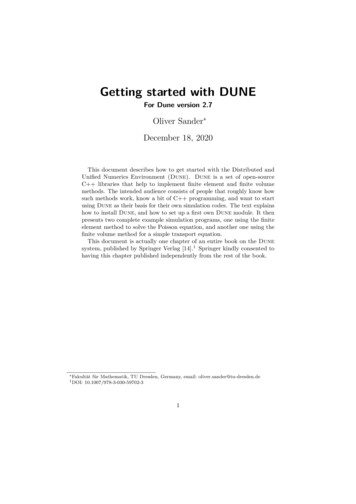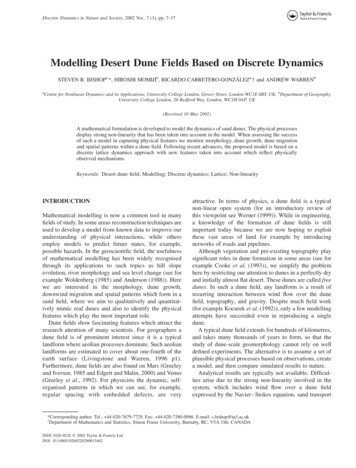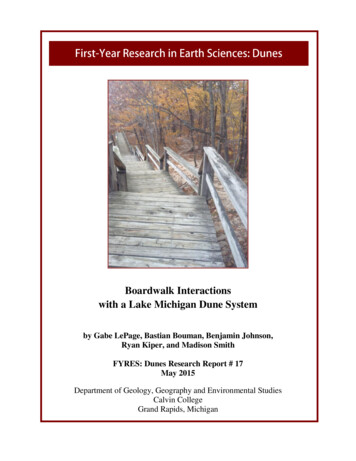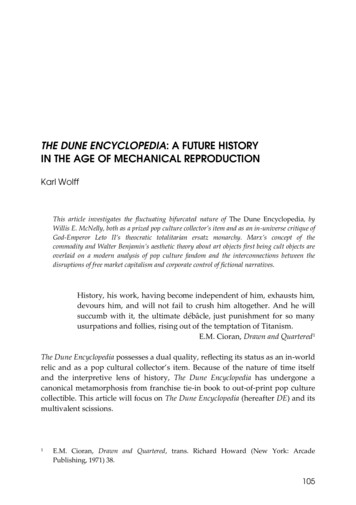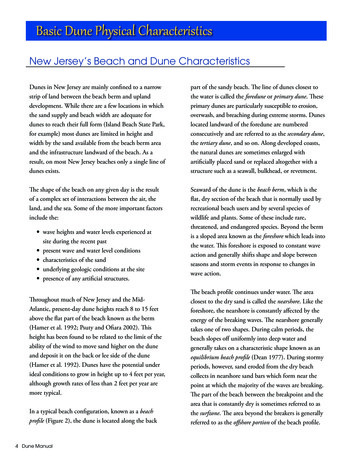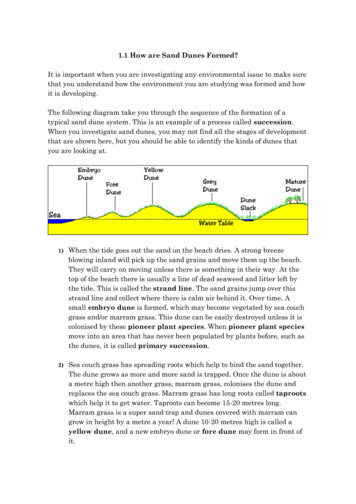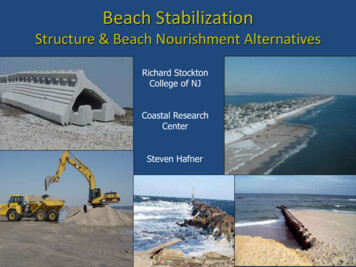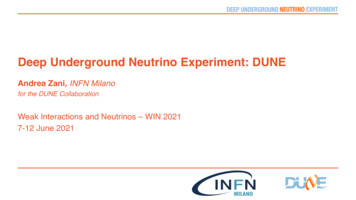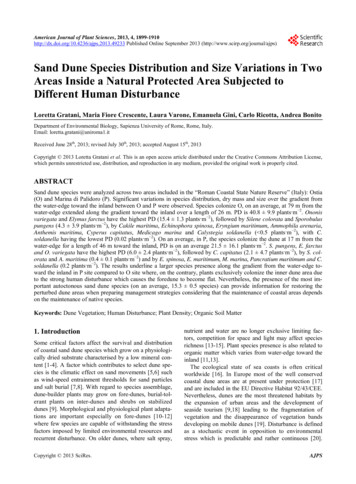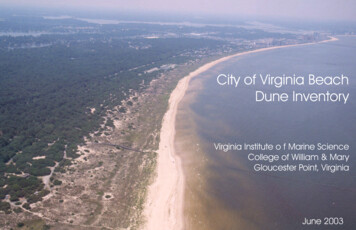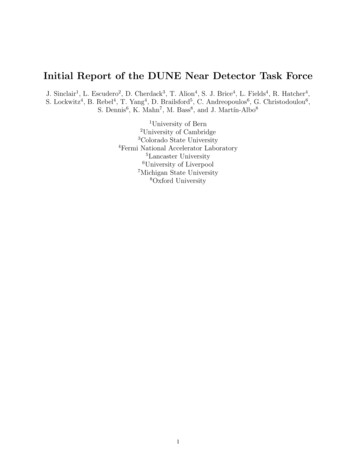
Transcription
Initial Report of the DUNE Near Detector Task ForceJ. Sinclair1 , L. Escudero2 , D. Cherdack3 , T. Alion4 , S. J. Brice4 , L. Fields4 , R. Hatcher4 ,S. Lockwitz4 , B. Rebel4 , T. Yang4 , D. Brailsford5 , C. Andreopoulos6 , G. Christodoulou6 ,S. Dennis6 , K. Mahn7 , M. Bass8 , and J. Martı́n-Albo81University of BernUniversity of Cambridge3Colorado State University4Fermi National Accelerator Laboratory5Lancaster University6University of Liverpool7Michigan State University8Oxford University21
Contents1 Introduction1.1 Charge . . . . . . . . . . . . . . . . . . . . . . . . . . . . . . . . . . . . . . . . . . . . . . . . .1.2 Personnel . . . . . . . . . . . . . . . . . . . . . . . . . . . . . . . . . . . . . . . . . . . . . . .1.3 Timeline . . . . . . . . . . . . . . . . . . . . . . . . . . . . . . . . . . . . . . . . . . . . . . . .11112 Overview23 Neutrino Fluxes and Uncertainties34 Neutrino Cross-Sections and Uncertainties55 External Backgrounds5.1 Cosmic Ray Induced Particles . . . . . . . . . . . . . . . . . . . . . . . . . . . . . . . . . . . .5.2 Particles Induced by Neutrino Interaction in the Rock . . . . . . . . . . . . . . . . . . . . . .99106 Near Detector Samples6.1 The Fine Grained Tracker . . . . . . . .6.1.1 Simulation . . . . . . . . . . . .6.1.2 Reconstruction . . . . . . . . . .6.2 The High Pressure Gaseous Argon TPC6.2.1 Simulation . . . . . . . . . . . .6.2.2 Reconstruction . . . . . . . . . .6.3 The Liquid Argon TPC . . . . . . . . .6.3.1 Simulation . . . . . . . . . . . .6.3.2 Reconstruction . . . . . . . . . .11111113141415161617.7 Near Detector Systematics8 The8.18.28.317VALOR Near Detector Fits: Constraining theParameter Estimation . . . . . . . . . . . . . . . . .Binning . . . . . . . . . . . . . . . . . . . . . . . . .Near-Detector Fitting Results . . . . . . . . . . . . .Systematic Uncertainties18. . . . . . . . . . . . . . . . . . . . . . . 18. . . . . . . . . . . . . . . . . . . . . . . 20. . . . . . . . . . . . . . . . . . . . . . . 219 The Far Detector Samples229.1 Simulation . . . . . . . . . . . . . . . . . . . . . . . . . . . . . . . . . . . . . . . . . . . . . . . 229.2 Reconstruction . . . . . . . . . . . . . . . . . . . . . . . . . . . . . . . . . . . . . . . . . . . . 2310 The Far Detector Fit10.1 Overview . . . . . . . . . . . . . . . . . . . . . . . .10.2 Systematic Uncertainties . . . . . . . . . . . . . . . .10.2.1 Inputs from VALOR (flux and cross section)10.2.2 Detector systematics . . . . . . . . . . . . . .10.3 Fit Results . . . . . . . . . . . . . . . . . . . . . . .10.3.1 Results from the LOAF fits . . . . . . . . . .10.3.2 The VALOR fits . . . . . . . . . . . . . . . .11 The11.111.211.3.2323242424242427Figures of Merit27FOMs: The ability of the detectors to enhance the oscillation analyses . . . . . . . . . . . . . 27FOMs: The performance of the detectors in the beam . . . . . . . . . . . . . . . . . . . . . . 28FOMs: The ability to do physics with the near detectors . . . . . . . . . . . . . . . . . . . . . 2812 Bibliography292
1Introduction1.1ChargeThe Near Detector Task Force of the DUNE collaboration started work in September of 2015 with thefollowing charge from the collaboration spokespeople Develop GEANT4 simulations of the reference design near detector and possiblealternatives Perform a full end-to-end simulation connecting the measurements in the neardetector to the far detector systematics using, for example, the VALOR framework Evaluate the potential benefits of augmenting the reference design with .– a LAr-TPC– the use of a High Pressure Gaseous TPC Produce a first report on their findings to the DUNE Technical Board by September2016 and a final report by March 2017.This document is the September 2016 Initial Report mandated by the last bullet of the charge.1.2PersonnelResponsibility for the work of the task force is divided into the following points of contactLeader and DeputiesInfrastructureFluxCross-Section Models and SystematicsFine Grained TrackerLiquid Argon TPCHigh Pressure Gaseous Argon TPCVALORFar DetectorFar Detector FitFigures of Merit1.3Steve Brice, Daniel Cherdack, and Kendall MahnRobert HatcherLaura FieldsLorena EscuderoTyler AlionSarah Lockwitz and James SinclairJusto Martı́n-AlboSteve Dennis and Costas AndreopoulosTingjun Yang and Tyler AlionDaniel CherdackBrian RebelTimelineThe work of the task force has been driven by a series of ”Run Throughs”, one every four months, wherethe complete processing chain is exercised from flux and cross-section calculation through near detectorsimulation and the constraining of systematics to the far detector simulation and final fitting. The processingchain is described in more detail in 2. The figure below shows the timeline for run throughs and how theymatch with collaboration meetings and the production of initial and final reports.The 1st Run Through of the processing chain occurred in January 2016 was designed to exercise all linksin the chain, but in a stripped down and corner cutting way. The idea was to make sure the chain worksand to catch any fundamental issues as soon as possible. The 1st Run Through did not have physics contentin its output. The 2nd Run Through occurred prior to the South Dakota collaboration meeting in April2016 and upgraded the physics and had some physics-useful output. The 3rd Run Through brought in manymore details of the physics with the aim of a much more defensible physics output and is the basis of thisinitial report. The 4th (and final) Run Through is scheduled for December 2016, just prior to the DUNEcollaboration meeting at CERN. The final report of the task force will be the result of a period of validationand physics studies following the 4th Run Through.1
Phase 1 - focus on machinerySept 2015 - Jan 2016 Milestone 1: First complete run through of the machinery (before Arlington meeting)-Jan 2016Phase 2 - incrementally add the necessary physics and improve simulationsJan 2016 - Sept 2016 Milestone 2: 2nd run through (before SURF meeting)-April 2016 Milestone 3: 3rd run through to generate material for initial report (before FNAL meeting)-August 2016 Milestone 4: Initial Report-September 2016Phase 3 - final improvements to the physics and simulationsSept 2016 - Mar 2017 Milestone 5: Final run through to generate material for final report (before CERN meeting)-December 2016 Milestone 6: Final Report-March 2017Near Detector Optimization Task Force62Figure 1: The timeline of the Near Detector Task Force workOverviewThe processing chain starts with the beam Monte Carlo generating neutrino fluxes for both near and farlocations and for all 4 relevant neutrino species (electron, muon, and their anti-particles). Along with thefluxes a flux error matrix is produced that encapsulates the effects and correlations of all known sources ofneutrino flux uncertainty. The flux generation step is summarized by the orange region of the process flowdiagram of Fig 2.The yellow region of the diagram above shows how the GENIE generator takes near and far neutrinofluxes and produces simulated neutrino interactions for each of the 3 near detector technologies as well asfor the far detector. The cross-section uncertainties and their effects on interaction probabilities and theoutgoing particles from the struck nucleus also originate from GENIE.There are three candidate near detector technologies being considered - Fine Grained Tracker (FGT),High Pressure Gaseous Argon TPC (HPTPC), and Liquid Argon TPC (LArTPC). Each of these has adedicated GEANT4 simulation and reconstruction and is represented by the horizontal pink region in theprocess flow diagram of Fig 2. Each technology also has its own systematic uncertainties. Each simulationreads the GENIE events that have been generated for it, runs the particles through a GEANT4 simulation ofthe detector and a simulation of the detector response, and then a reconstruction of the final state particlesand processes. All three simulations share an identical geometry description for the detector hall, shaft, andsurrounding rock; cosmics and rock events are also be generated with this geometry and inserted into theseparate detector simulations.The pink region on the right of the process flow diagram above represents the VALOR step where the neardetector simulated data and the systematic uncertainties are input to a minimization process that outputsconstrained uncertainties.2
DUNE WG Interfaces for the NDTF(ND Evaluations)Flux Sim WG(G4LBNE)FluxModelFlux PriorUncertaintiesExternal DataNDWGCross Section andNuclear ModelsFGTNDResponsesFD ResponseLArTPCGArTPCFastMCND FitCross Section andNuclear ModelPrior UncertaintiesNDPWG(GENIE )NDSamples(Det Sim and Evaluations)ND Uncertainties(Det Sim WGs)FDSamplesUncertaintiesAfter NDConstraintsNDTFFD Sim & Fast MC WGsFoMFD UncertaintiesLBPWGFD FitFullSimFigure 2: Overview of the processing chainThe cyan region of the process flow diagram describes the simulation of far detector data using fluxesderived from the same simulation that produced the near detector fluxes. The cross-section are also incommon with those used in the near detector simulations. Far detector uncertainties and event samples arethen fed into a final fit process.The final fit extracts CP violation sensitivity from the far detector simulation and the constrained uncertainties output by VALOR. A number of figures of merit (FOMs) are extracted from this fit and combinedwith FOMs describing more basic near detector quantities like efficiencies, resolutions, and acceptances.3Neutrino Fluxes and UncertaintiesThe neutrino flux simulation uses G4LBNF version v3r4p2 which is a configurable Geant4-based simulationof the DUNE beamline. For these fluxes, G4LBNF is configured to simulate the optimized beam describedin the Beam Optimization Task Force Interim Report [1]. That beam includes a 200 cm long graphite targetdivided into fins that are each 13.4 mm wide by 20 mm high and separated by 0.2 mm. The primary protonbeam momentum is 80 GeV, and has a RMS of 1.63 mm in both the x and y directions, and arrives in spillscorresponding to 7.5e13 protons per spill. Charged particles produced in the target are focused by threefocusing horns. The target starts 8 cm downstream of the start of Horn 1 (the point commonly referred toas MCZERO), and the second (third) horn begins 2.63 (18.48) m downstream of MCZERO. The decay pipeis 194 meters long with a radius of 2 m. The hadron absorber and shielding around the target, horns anddecay pipe are simulated but have little effect on the neutrino flux. Given current PIP II power estimates,we expect to receive 1.47 1021 protons on target per year at 80 GeV. The optimized and reference νµ fluxesare shown in Fig. 3.The basic output of G4LBNF is an ntuple containing a branch for each neutrino produced in the beamsimulation, formatted in the dk2nu common flux ntuple format. Output files corresponding to 1e8 POT eachin neutrino mode and antineutrino mode are output. A similar set of files corresponding to the referencedesign described in the 2015 DUNE CDR are also available.The flux systematic uncertainties come in the form of a 208 x 208 covariance matrix, corresponding to twodetector locations (near and far), two running modes (neutrino and antineutrino), and four neutrino species3
Figure 3: The optimized and reference νµ fluxes in forward horn current mode.per mode (muon neutrinos, muon antineutrinos, electron neutrinos and electron antineutrinos). Nineteenenergy bins are provided for the muon neutrino and muon antineutrinos fluxes, with bin edges at 0, 0.5, 1,1.5, 2, 2.5, 3, 3.5, 4, 4.5, 5, 5.5, 6, 7, 8, 12, 16, 20, 40, and 100 GeV. Seven bins are provided for the electronneutrino and electron antineutrino fluxes, with bin edges at 0, 2, 4, 6, 8, 10, 20, and 100 GeV. Matrices existfor both the optimized and reference beam options.The covariance matrices are sums of two matrices which separately describe hadron production andbeam alignment uncertainties. The hadron production uncertainties are estimated using the PPFX packagedeveloped by Leo Aliaga for MINERvA and extended to DUNE by Amit Bashyal. PPFX is documentedin Leo Aliaga’s thesis [2] while the expansion for Dune is described in a talk by Amit Bashyal [3]. Thecalculated hadron production uncertainties correspond to the flux at the center of the near and far detectors.For the far detector, this is an excellent approximation of uncertainties on flux over the entire detector, butthis may not be the case for the near detector uncertainties. In particular, correlations between the nearand far detector errors are likely overestimated as a result of this.The alignment uncertainties are estimated by running simulations with each of the underlying uncertainparameters (horn currents, horn position, target positions, number of protons on target, etc) varied by onestandard deviation from their nominal values. In some cases, we take the difference between the resultingflux and the nominal flux as the systematic uncertainty for that alignment parameter. In other cases, werun simulations for several other variations (for example two, four and six standard deviations) and fit theresulting fluxes to estimate the change in flux for one standard deviation. This work is described in moredetail in two technical notes ”LBNE Beam Alignment Tolerances and Systematic Uncertainties” [4] cument?docid 1486 [5].For all systematic uncertainties, underlying parameters are simultaneously changed for all neutrino fluxes,running modes and detector positions, so that correlations between the resulting uncertainties are properlycalculated and propagated to the total covariance matrix. However, large statistical fluctuations are presentin the case of the alignment parameter variations, which may cause under- or over- estimation of correlations.The flux uncertainties over the 208 bins are shown in Fig. 4 and the full 208x208 correlation matrix isshown in Fig. 54
Figure 4: The a priori flux uncertainties. Details of the binning are given in the text of Sec. 3.4Neutrino Cross-Sections and UncertaintiesFor the present analysis, a fairly comprehensive list of neutrino interaction systematics is implemented: weconsider 43 neutrino interaction systematics parameterizing the uncertainties on a wide range of neutrinointeraction modeling aspects relevant to DUNE, as listed below. For the DUNE oscillation sensitivity simulation and Near Detector optimization task, we want to give the VALOR fit sufficient freedom to vary thecross-section model and, also, ensure that it is the Near Detector data and not the priors that drive theDUNE systematics constraint. Therefore, appropriately conservative prior uncertainties are calculated bythe VALOR group, using the GENIE event re-weighting tools. Multiple comparisons with external data areperformed in collaboration with the GENIE group, in support of the systematic error assignments used in thisanalysis. Some of these data/MC comparisons are shown in the Appendix A of the VALOR DUNE technicalnote (available at DUNE-doc-1291 [6], and in preparation DUNE-doc-1712 [7]). Largely model-independentneutrino interaction systematics are used.The following 43 neutrino interaction systematic parameters are included, defined in kinematical rangeschosen to ensure sufficient statistics in each bin:0-2) 3 νµ CCQE systematics for the following true kinematic bins:– Q2 0.2 GeV2– 0.2 GeV2 Q2 0.55 GeV2– Q2 0.55 GeV25
Figure 5: The a priori flux correlation matrix. Details of the binning are given in the text of Sec. 3.3-5) 3 ν̄µ CCQE systematics for the following true kinematic bins:– Q2 0.2 GeV2– 0.2 GeV2 Q2 0.55 GeV2– Q2 0.55 GeV26) 1 νµ CC MEC systematic - 100% uncorrelated uncertainty added for now7) 1 ν̄µ CC MEC systematic - 100% uncorrelated uncertainty added for now8-10) 3 νµ CC 1π systematics for the following true kinematic bins:– Q2 0.3 GeV2– 0.3 GeV2 Q2 0.8 GeV2– Q2 0.8 GeV211-13) 3 ν̄µ CC 1π systematics for the following true kinematic bins:– Q2 0.3 GeV2– 0.3 GeV2 Q2 0.8 GeV2– Q2 0.8 GeV26
14-16) 3 νµ CC 1π 0 systematics for the following true kinematic bins:– Q2 0.35 GeV2– 0.35 GeV2 Q2 0.9 GeV2– Q2 0.9 GeV217-19) 3 ν̄µ CC 1π 0 systematics for the following true kinematic bins:– Q2 0.35 GeV2– 0.35 GeV2 Q2 0.9 GeV2– Q2 0.9 GeV220) 1 νµ CC 2π systematic21) 1 ν̄µ CC 2π systematic22-24) 3 νµ CC DIS systematics for the following true kinematic bins:– Eν 7.5 GeV– 7.5 GeV Eν 15 GeV– Eν 15 GeV25-27) 3 ν̄µ CC DIS systematics for the following true kinematic bins:– Eν 7.5 GeV– 7.5 GeV Eν 15 GeV– Eν 15 GeV28) 1 νµ CC coherent systematic29) 1 ν̄µ CC coherent systematic30) 1 νµ NC systematic31) 1 ν̄µ NC systematic32) 1 νe /νµ cross-section ratio systematic33-42) 10 final state re-interaction (FSI) systematics:33) pion mean free path, controlling the pions re-interaction rate34) nucleon mean free path, controlling the nucleon re-interaction rate35) fraction of rescattered pions in charge exchange channels36) fraction of rescattered pions in inelastic channels37) fraction of rescattered pions in absorption channels38) fraction of rescattered pions in pion production channels39) fraction of rescattered nucleons in charge exchange channels40) fraction of rescattered nucleons in inelastic channels41) fraction of rescattered nucleons in absorption channels42) fraction of rescattered nucleons in pion production channels7
The last 10 systematics parameterize FSI effects. They are non-linear systematics and they are appliedto every single multi-dimensional kinematic bin, of each one of the MC templates used for each one of thefit samples of the present analysis. The response of each individual bin to each of the 10 FSI systematics ispre-computed for a range of values of each systematic. Using the pre-computed values, the response of eachbin is parameterized using cubic splines which are interrogated during the process of producing any singleset of VALOR DUNE predictions. Separate response functions are calculated for each of the 3 detectoroptions, using the outputs of the corresponding simulation chain. Although in the covariance matrix theseFSI parameters are taken to be uncorrelated with other systematic parameters, correlations between allkinematical bins are taken into account.The first 33 parameters listed describe the uncertainty in the cross-section for the corresponding processin the absence of FSI effects, and they are linear parameters applied in the appropriate kinematical range ofthe MC templates corresponding to the appropriate true reaction mode (more details are given in Appendix Bof [6]). For them, a covariance matrix is computed using a sample of 100k νµ and 100k ν̄µ events generatedusing GENIE v2.10.6 and the optimized neutrino flux histograms. The procedure itself is largely modelagnostic, and translates the effect of several model-dependent parameters to an appropriately chosen set ofprimarily linear model-independent ones. This covariance matrix is constructed using GENIE re-weightingtools.Figure 6: The a priori cross-section uncertainties. Left: effect of the 1σ variation of each GENIE parameter(in the Y axis) in each one of our model-independent parameters (in the X axis). Right: uncertainties in themodel-independent parameters, calculated by adding in quadrature the effects of each GENIE parametershown in the left plot.A two-step process is used to obtain conservative prior errors:1. Firstly, the effect of the 1σ variation of each GENIE model parameter is calculated by varying itindependently of the others in order to avoid potential cancellations that may occur when several parameters affecting the same bins are tweaked at the same time. For each of the model-independentparameters listed above, the effects of the 1σ variation of each GENIE parameter are added in quadrature. This is calculated by varying the GENIE parameters with a 1σ variation and a -1σ variation,and choosing the maximum total uncertainty. Figure 6 (left) shows the effect of the 1σ variation ofeach GENIE parameter (in the Y axis) in each one of our model-independent parameters (in the Xaxis); these effects are then added in quadrature to compute the uncertainties in the model-independentparameters, presented in 6 (right). Notice that the red(blue) labels in the Y axis in Fig. 6 (left) denote8
parameters related to CC(NC) interactions, while black denotes both CC NC interactions, and italictext is used when the labels refer to parameters applied only to antineutrino interactions.2. Secondly, the correlations between any of the 33 parameters listed above are calculated as well. To dothis, all the GENIE parameters are varied simultaneously. These correlations are illustrated in Figure7.Figure 7: The a priori cross-section correlation matrixBy combining the results from both steps (uncertainties from the first one and correlations from thesecond one), the final covariance matrix is built for the neutrino interaction uncertainties, input to theVALOR fit.5External BackgroundsThe neutrino interaction samples described in the later sections ?, ?, and ? have mixed in with themthe appropriate amounts of cosmic ray induced particles and particles originating from neutrino interactionsin the rock surrounding the DUNE near hall. The next two sections describe the creation of these twobackground samples.5.1Cosmic Ray Induced ParticlesThe cosmics simulation for the NDTF is based in LArSoft and relies on LArSoft modules that have beendeveloped and used by other experiments to produce cosmics samples. The overall approach is to usea cosmic ray Monte Carlo generation library to generate muons and neutrons that are then propagated9
through the LArND geometry using Geant4. The outputs are extracted at the end and made available asntuples describing cosmogenic particles passing through the boundaries of the ND hall.Throughout the simulation the LArND geometry is used because it is compatible with LArSoft and soallows the use of available LArSoft modules. In the end the particles are extracted at the boundary of theND hall so the detector geometry is irrelevant to the goals of the overall cosmic simulation. The cosmic-rayshower library (CRY) is used via the CosmicsGen larsim module to generate muons and neutrons at the levelof the ND. These particles are then moved back to the edge of the world volume using their trajectories.The output is then propagated through the geometry using the largeant module and the particles reachingthe boundary of the ND hall are extracted into separate ntuples with a custom larsoft producer module.From the surface level to the top of the ND hall there is 53 m of material with the first 20 m being dirt(1.7 g/cm3) and the the remaining 33 m being rock (2.43 g/cm3).A sample of 10,000 5 ms blocks of time are simulated. The simulation predicts a muon rate of 2.7 Hz/m2at the top of the ND hall. This is in reasonable agreement with the measured rate in the MINOS hall, 0.8Hz/m2 given their differences in depth ( 53 m vs 93 m). In addition to muon fluxes the other particlescoming out of Geant4 are also kept (neutrons, protons, pions, electrons, kaons) allowing them to be overlaidin the various ND simulations. Specific issues that could be addressed to generate more detailed/accuratefluxes in the future are: The geometry has values for the density of dirt (1.7 g/cm3) that differs from the value used in theMINOS simulations (2.29 g/cm3). These values should be updated to the MINOS values which willdecrease the cosmogenic flux slightly. The world volume of the geometry should be expanded to increase the dirt/rock that is traversed bythe more horizontal muon flux. This would reduce the horizontal flux which is expected to be anoverestimate in its current configuration. CRY generates the cosmic flux expected at sea level, 2100 m, or 11,300 m. A possible improvementhere could use a higher elevation with a modified geometry or a different generator (e.g. CORSIKA). CRY has wide bins in energy and zenith angle which lead to binning artifacts in the resulting flux.This is a relatively small effect, but could be addressed by moving to another generator.5.2Particles Induced by Neutrino Interaction in the RockThe simulation of particles induced by neutrino interactions occurring in the rock surrounding the NearDetector (ND) cavern (hereafter refered to as rock events) is separated into three stages, all of which areoutside of the ART (and LArSoft) framework. The ultimate output of the simulation is a set of particlestates (position, momentum etc.) located on the inner side of the ND cavern walls which are matched to therock events that created them. All steps of the rock event generation use the ND world geometry in gdmlformat.The first step of the simulation is generation of the neutrino flux incident on the cavern and the surrounding rock. The simulation utilises a converter (generate gsimple.sh from gsimple v2 8 6c) which converts”dk2nu” flux information to a set of neutrino rays (”gsimple” rays) that pass through a user defined 2D fluxwindow. To ensure that the simulation is all encompassing, the flux window is chosen to be 760 x 540 m2in size, 275 m downstream of the ND cavern and oriented such that the beam direction vector is normalto the flux window. All chosen values are based on simple path length calculations for a 120 GeV muon(the simulations highest available energy) just reaching the ND cavern. The DUNE reference beam design(ref 01 in dk2nu format) is used to produce 1,000 gsimple files, each containing 10,000 neutrino rays. Notethe reference beam flux is used here rather than the optimized flux used everywhere else. This difference isexpected to have negligible consequences. The POT per file is 4 x 103.The second step of the simulation is neutrino event generation in the surrounding rock. The gev gen fnalexecutable (GENIE v2 8 6c) is used, taking a randomized subset of the gsimple flux files as inputs. Anadaptable fiducial volume (known as the flexible rock box) is used in the processing. It defines a varyingfiducial volume around the ND cavern whose size is calculated based on the path length of a given neutrinointeractions final state particles. The flexible rock box helps to remove neutrino events in which the finalstate particles have no hope of reaching the ND cavern. The output of gev gen fnal is a set of single neutrino10
interaction events with POT accounting and a recording of the relevant gsimple information used in theevent processing. A total of 1950 files have been produced, each containing 10,000 GENIE interactions. ThePOT per output file is 1.5 x 1014.The final step of the simulation is the tracking of the GENIE final states. Geant4 (v4 10 1 p03), setupwith the QGSP BERT HP physics list, is used to propagate the GENIE final states (labeled with kIStStableFinalState) up to their entrance into the ND cavern, where the tracking stops. The particle state informationat this point (position, momentum and particle species) is repackaged into the original GENIE event recordalong with a recording of the original final state as the particles mother. Finally, the ND cavern enteringparticles are labeled such that they should be tracked (with kIStStableFinalState) whereas the original finalstate particles are labeled with some other GENIE label (kIStUndefined). This relabeling scheme means thatany downstream tracking algorithm that takes a genie event record as an input will only track the particlesfrom where they enter the ND cavern, whilst correctly ignoring the original GENIE final states. A total of1911 have been successfully produced, each containing 1200 rock events. The POT per file is identical tothat in step two ( 1.5 x 1014). The expected number of rock events for a DUNE spill (7.5 x 1013 POT) is600.There are a few items to note: The calculation of the flux window dimensions are based on a 120 GeV muon originating from thecorners of the flux window and just reaching the ND cavern. Such an event would be very forwardgoing, meaning that the flux window could be shrunk in future iterations. The approach used herehowever is more inclusive of the physics and the trade off, which is minor in terms of processing time,is CPU efficiency. All path length calculations for the flux window assume a rock density of 1.7 g/cm3 whereas the densityused in GENIEs flexible rock box fiducial volume is 2.5 g/cm3. The lower density for the former willhave further unnecessarily inflated the size of the flux window. Any neutrinos produced in the tracking stage, including those originating from the GENIE vertex, areimmediately killed. The QGSP BERT HP physics list for the tracking stage is chosen due to its wide use in HEP experiments and its ability to track neutrons more precisely than other physics lists. Any intermediaries produced in the tracking stage have not been recorded in the genie event record.6Near Detector SamplesFor each of the three candidate near detector technologies a large sample of simulated events has beenproduced in both forward and reverse horn current modes. These samples are used to understand how welleach ND technology can constrain the systematic errors relevant to a long baseline oscillation analysis. Thesamples are also used to enumerate some basic detector properties, efficiencies, acceptances, etc.Because of the 18 month duration of the taskforce work it is not possible to develo
developed by Leo Aliaga for MINERvA and extended to DUNE by Amit Bashyal. PPFX is documented in Leo Aliaga's thesis [2] while the expansion for Dune is described in a talk by Amit Bashyal [3]. The calculated hadron production uncertainties correspond to the ux at the center of the near and far detectors.

